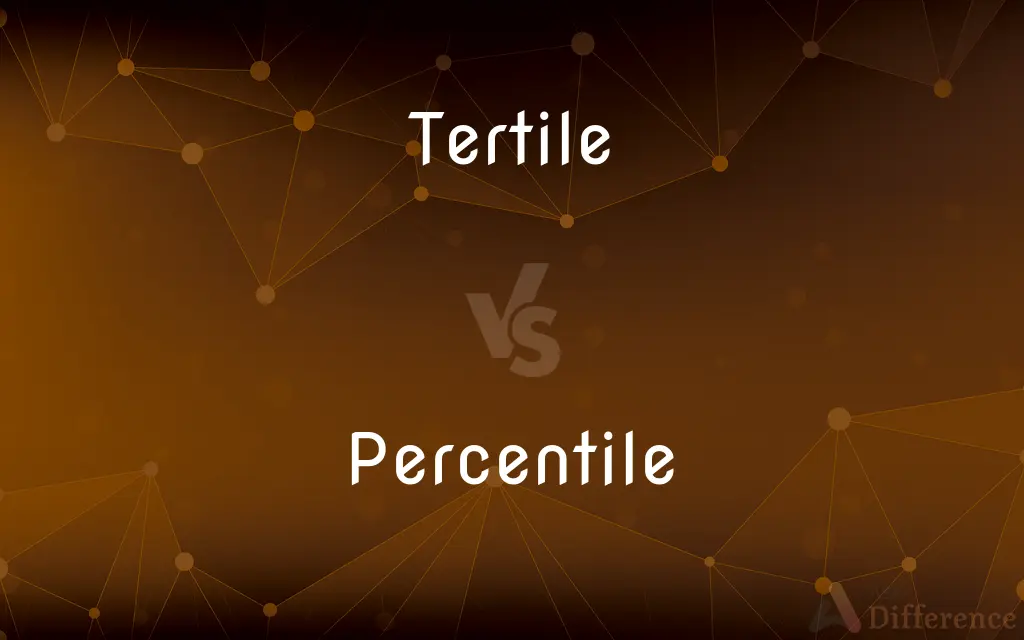Tertile vs. Percentile — What's the Difference?
By Tayyaba Rehman & Urooj Arif — Updated on April 3, 2024
Tertiles divide data into three equal parts, focusing on the distribution's spread, while percentiles split data into 100 equal segments to detail fine-grained position.

Difference Between Tertile and Percentile
Table of Contents
ADVERTISEMENT
Key Differences
Tertiles are a method of dividing a dataset into three equal parts based on its values, providing a broad overview of the distribution. Each tertile represents one-third of the data, highlighting the lower, middle, and upper segments of the distribution. This division helps in understanding the spread and general characteristics of the data, useful for identifying trends or disparities within the dataset. On the other hand, percentiles divide the data into 100 equal parts, offering a much more detailed view. Each percentile indicates a value below which a certain percent of observations fall, making it especially valuable for detailed comparisons, such as understanding the exact position of an individual score within a large dataset.
While tertiles give a more generalized understanding by dividing the data into broad segments, percentiles allow for precise positioning within the dataset. The tertile method simplifies data analysis by focusing on three major divisions, which can be particularly helpful in quickly identifying distribution characteristics without needing overly detailed data analysis. Whereas percentiles, by splitting the data into 100 parts, are essential for detailed statistical analysis, such as in educational assessments or competitive exams where understanding the exact rank is crucial.
Tertiles are typically used in fields or scenarios where a broad categorization is sufficient for analysis or decision-making. They simplify complex data sets by highlighting basic distribution trends, making it easier to communicate findings to a non-technical audience. In contrast, percentiles are preferred in contexts requiring high precision, such as academic assessments or in-depth research studies, where understanding the fine nuances of data distribution is necessary.
The calculation and interpretation of tertiles can be straightforward, making them accessible for quick assessments and general analysis. This approach is beneficial for initial stages of data exploration or when the dataset is not too complex. Percentiles, however, require more detailed calculations and interpretations, offering nuanced insights into the data's behavior, particularly useful for identifying outliers or for detailed performance evaluations.
In practical application, tertiles might be used in economic studies to categorize income levels into low, middle, and high, providing a clear but broad picture of income distribution. Percentiles, however, are often used in educational settings, such as determining a student's performance relative to peers, offering a precise measurement of individual achievement.
ADVERTISEMENT
Comparison Chart
Division
Divides data into 3 equal parts.
Divides data into 100 equal parts.
Purpose
Gives a broad overview of distribution.
Provides detailed positioning within the dataset.
Usage Scenario
Useful for general trends and basic distribution characteristics.
Essential for detailed analysis and precise comparisons.
Interpretation
Straightforward, ideal for quick assessments.
Detailed, suitable for in-depth analyses.
Typical Application
Economic studies for categorizing income levels.
Educational assessments to determine precise student rankings.
Compare with Definitions
Tertile
A statistical measure dividing data into three equal parts.
The median income was in the top tertile of the study's dataset.
Percentile
Used for detailed data comparison and analysis.
The survey results are typically presented in percentiles to show detailed customer satisfaction levels.
Tertile
Reflects broad segments of data distribution.
The company's revenue falls into the middle tertile among competitors.
Percentile
Essential in academic and competitive assessments.
Achieving a percentile above 95 is crucial for admission to top universities.
Tertile
Simplifies data analysis by highlighting general trends.
In terms of sales volume, we aim to reach at least the second tertile this quarter.
Percentile
Utilized in research for nuanced insights.
The study used percentile ranks to evaluate the effectiveness of the new treatment.
Tertile
Used in basic economic and social research.
His academic performance placed him in the first tertile of the class.
Percentile
A measure indicating the value below which a given percentage of observations in a group falls.
Her test score was in the 90th percentile, indicating high achievement.
Tertile
Helps in quick data categorization.
Based on the tertile analysis, we can focus our marketing efforts on the upper-third customers.
Percentile
Offers precise data positioning and ranking.
His salary is in the 75th percentile for his industry, indicating above-average earnings.
Tertile
(statistics) Either of the two points that divide an ordered distribution into three parts, each containing a third of the population.
Percentile
In statistics, a percentile (or a centile) is a score below which a given percentage of scores in its frequency distribution falls (exclusive definition) or a score at or below which a given percentage falls (inclusive definition). For example, the 50th percentile (the median) is the score below which (exclusive) or at or below which (inclusive) 50% of the scores in the distribution may be found.
Tertile
(statistics) Any one of the three groups so divided.
The first tertile results include January through April's revenues.
Percentile
Each of the 100 equal groups into which a population can be divided according to the distribution of values of a particular variable.
Percentile
Any of the groups that result when a frequency distribution is divided into 100 groups of equal size.
Percentile
Any of the values that separate each of these groups.
Percentile
(statistics) Any of the ninety-nine points that divide an ordered distribution into one hundred parts, each containing one per cent of the population.
Percentile
(statistics) Any one of the hundred groups so divided.
He is highly intelligent – he has an IQ in the top percentile.
Percentile
(statistics) any of the 99 numbered points that divide an ordered set of scores into 100 parts each of which contains one-hundredth of the total
Common Curiosities
What is the purpose of using tertiles?
They provide a broad overview of data, simplifying the analysis by highlighting general trends.
Can tertiles be used for detailed data analysis?
Typically, tertiles are more suited for broad categorization rather than detailed analysis.
Where are tertiles commonly applied?
In economic and social research to categorize variables like income levels.
What are tertiles?
Tertiles divide a dataset into three equal parts, each representing one-third of the data distribution.
Why are percentiles important?
They provide detailed positioning within a dataset, essential for precise comparisons and analyses.
How do percentiles benefit educational assessments?
They allow for a precise understanding of a student's performance relative to peers.
How do tertiles differ from quartiles?
Tertiles split data into three parts, while quartiles divide it into four equal segments.
What are percentiles?
Percentiles are a statistical measure indicating the value below which a certain percent of observations fall.
In what scenarios are percentiles preferred over tertiles?
When detailed data comparison and analysis are required, such as in competitive exams or in-depth research.
Are percentiles used in economic studies?
Yes, for detailed analyses like wage distribution, but tertiles are often preferred for broader categorizations.
Share Your Discovery

Previous Comparison
Periodic vs. Periodically
Next Comparison
Supermarket vs. GroceryAuthor Spotlight
Written by
Tayyaba RehmanTayyaba Rehman is a distinguished writer, currently serving as a primary contributor to askdifference.com. As a researcher in semantics and etymology, Tayyaba's passion for the complexity of languages and their distinctions has found a perfect home on the platform. Tayyaba delves into the intricacies of language, distinguishing between commonly confused words and phrases, thereby providing clarity for readers worldwide.
Co-written by
Urooj ArifUrooj is a skilled content writer at Ask Difference, known for her exceptional ability to simplify complex topics into engaging and informative content. With a passion for research and a flair for clear, concise writing, she consistently delivers articles that resonate with our diverse audience.















































